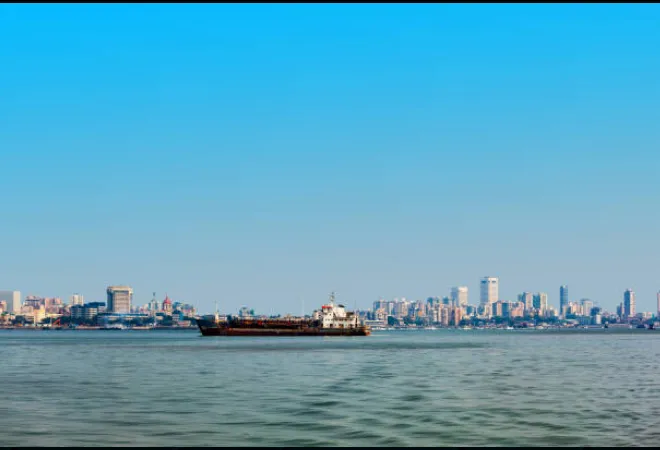
This article is part of the series Colaba Edit 2021.
Ever since the Portuguese handed over the then settlement of Bombay to the English in 1661, the city developed rapidly to become the centre of gravity of the burgeoning British Empire, of its maritime security in the Indian Ocean Region and the Eastern hemisphere, and also of India’s industrial development and prosperity. Clearly, this was because Mumbai is arguably the finest natural harbour to be found on either coast, which made it India’s natural gateway to the world, and the nerve-centre of its international trade. Mumbai’s heritage and experience is to its great advantage in today’s increasingly interconnected world, in which the maritime dimension has taken centre-stage.
Mumbai also became a formidable naval base for the British, and remains the seat of the Western Naval Command of the Indian Navy, with its massive Dockyard, whose multifarious requirements have spurred industrial activity and growth in the city over three centuries. On account of its strategic location with respect to the Suez Canal, the Horn of Africa, the Gulf of Aden, the Persian Gulf, and later, with respect to an antagonistic neighbour in Pakistan, Mumbai is vital for India’s energy security, its trade flows, and for safeguarding the entire West Coast from traditional and non-traditional threats.
The presence of the Navy in the heart of this great city underscores the link between trade, security and prosperity, as starkly recorded in history, and demonstrated by a succession of great powers. Navies not only address threats, but also further and protect economic interests. As the saying goes, “Trade follows Flag, and Flag follows Trade.”
Mumbai’s heritage and experience is to its great advantage in today’s increasingly interconnected world, in which the maritime dimension has taken centre-stage.
Water covers 70 percent of the earth’s surface; about 80 percent of the world’s population lives near the ocean—within 200 miles of it—and approximately 90 percent of all international trade and energy lifelines traverse the sea. Over 150 of the 195 member states of the UN are coastal states. The centres of population and industry are all packed around the coastlines of the continents. This region bordering the sea, referred to as the littoral, is the most industrialised and developed part of the planet.
The oceans are also a treasure trove of living and non-living resources, and a major factor for food security, mineral sourcing/mining, and maybe even as an antidote for water scarcity. This is inevitably leading to greater maritime conflict, and what can only be termed as increasing ‘territorialisation’ of the seas, as most tellingly witnessed in the South China Sea.
The increasingly contested and vast oceanic spaces have progressively occupied strategic centre-stage in recent times, and the 21st-century has been aptly described as the ‘century of the seas’. The ‘Indo-Pacific’ strategic construct is an example of the overarching significance of the maritime dimension in the international geopolitical and geo-economic arena.
It is, indeed, poised to catalyse the growth of a Blue Economy, and generate the requisite Blue Finance to support the growth of the maritime sector sustainably, setting an example for the rest of the India’s coastal cities and states.
Mumbai is ideally placed to be one of the world’s maritime epicentres in this oceanic or ‘Blue’ century swiftly unfolding before our eyes. It is, indeed, poised to catalyse the growth of a Blue Economy, and generate the requisite Blue Finance to support the growth of the maritime sector sustainably, setting an example for the rest of the India’s coastal cities and states.
The city’s maritime pre-eminence has, however, suffered since Independence, as the city’s maritime infrastructure and vision did not kept pace with the potential and opportunities afforded to Mumbai on account of its geographical location, and its status as India’s leading port and financial capital. Inadequate attention was paid to the development of suitable bridges, tunnels, wharfs, marinas, water transportation and logistics hubs, reclamations, modern fishing harbours and so on. Along with the port, the waterfront stagnated due to the absence of focus and imagination.
Not only did this prevent growth of the maritime economy, but also stunted the development of the city as a whole, confining it to a narrow strip of land, with consequent overcrowding, loss of investment and productivity, and poor quality of life for its citizenry. Coastal security also suffered on account of haphazard, unregulated fishing activity, and traffic generated by prospecting and production in the offshore oil and gas fields.
Fortunately for the city, the two decades since the turn of the millennium have seen a resurgence of interest in the maritime and coastal sector, on the part of both the government and informed citizens’ groups. There has been increasing awareness of the opportunities and potentialities offered by the planned development of maritime connectivity, infrastructure and economic activity, through public-private partnerships, investments and exchange of ideas between the many stakeholders connected with the maritime sector.
Coastal security also suffered on account of haphazard, unregulated fishing activity, and traffic generated by prospecting and production in the offshore oil and gas fields.
There is undoubtedly an urgent need for engagement, planning and investment in marine connectivity infrastructure and coastal roads; seaports upgradation; coastal transportation hubs; coastal tourism; waterfront development; marinas and water-sports; fishing and aquaculture; warehousing; marine pollution measures; and coastal security mechanisms. This maritime development is, indeed, vital for Mumbai’s future as a world-class coastal city, which can draw global investments and expertise.
The time is nigh for Mumbai to acknowledge and embrace the ‘Blue Imperative’, and launch a series of co-ordinated public and private initiatives to enhance the city’s prosperity, security and global status, whilst also significantly reducing environmental risks and ecological degradation, in keeping with the UN Sustainable Development Goals (SDG14) to “conserve oceans and seas”. The ‘Colaba Conversation’ offers a multi-disciplinary congregation to take cognisance of the Blue Imperative in a cohesive manner.
The views expressed above belong to the author(s). ORF research and analyses now available on Telegram! Click here to access our curated content — blogs, longforms and interviews.




 PREV
PREV


